1801-1802 North Carolina Revivals (10 revivals)

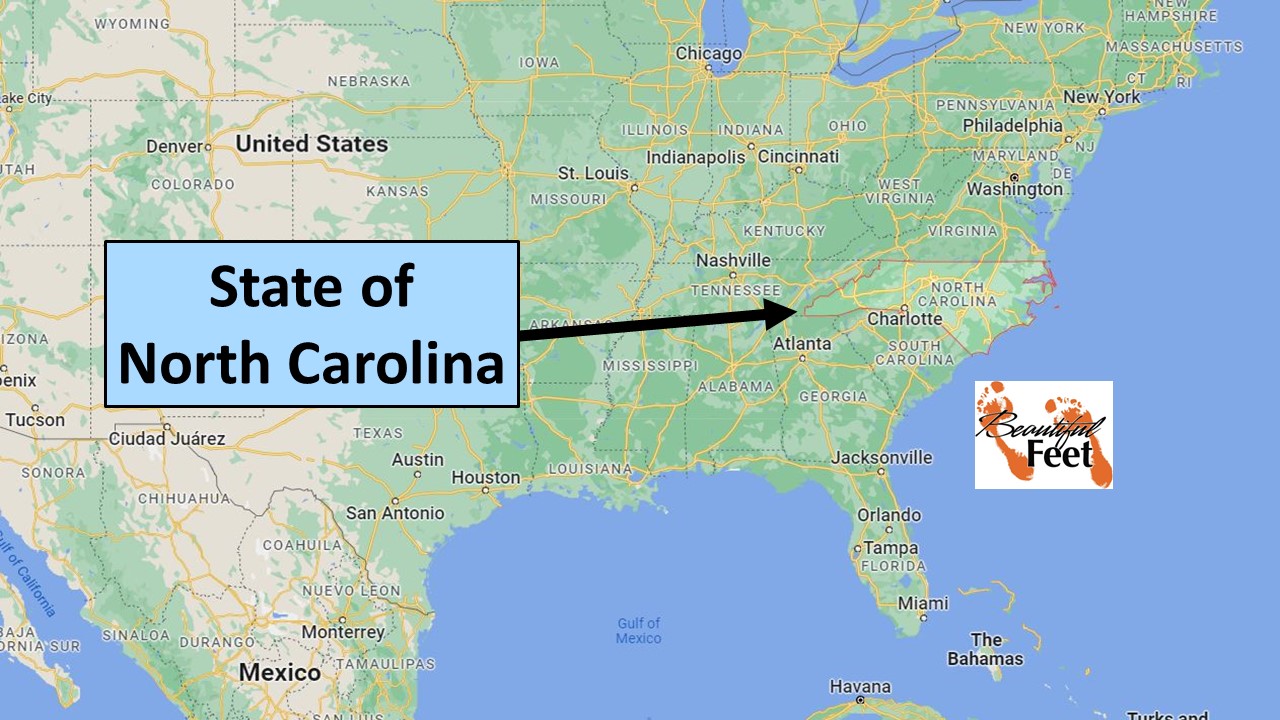
Background
Occurring at the same time as the revivals in North Carolina were revivals in many different locations throughout the United States, for it was at this time that the national movement known as the Second Great Awakening was well underway.
Here are a few of the revivals that were part of the Second Great Awakening:
► 1790-1840 2nd Great Awakening
► 1797 New England Revivals
► 1800s United Brethren Revivals
► 1800 Red River Revival
► 1801 Cane Ridge Revival
► 1802 Yale College Revivals
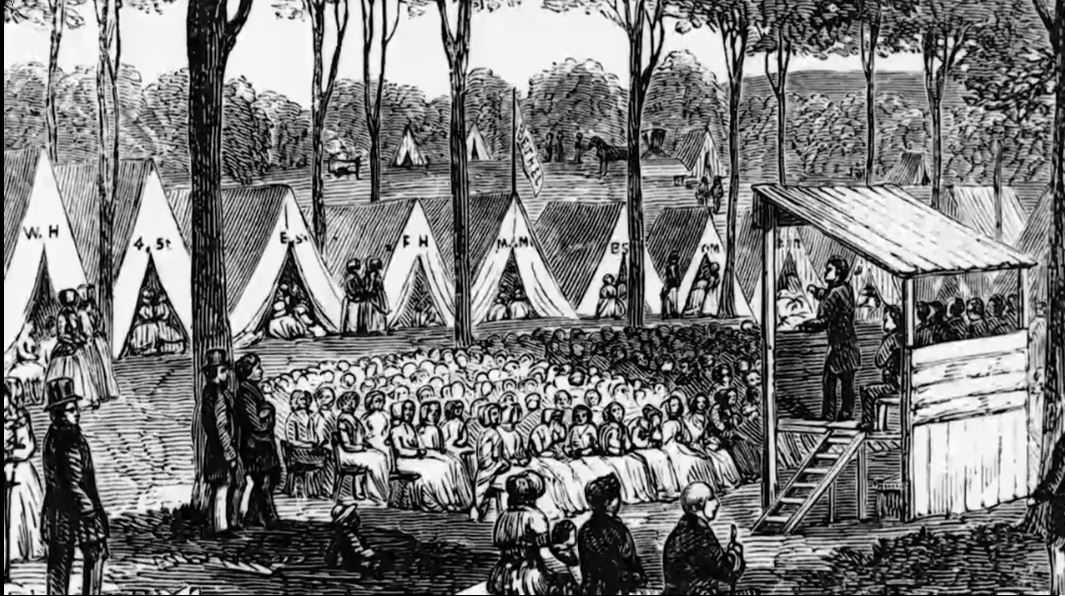
Typical setting of a camp meeting
Introduction—Camp Meetings
From an assortment of letters we have pieced together a series of revivals that occurred in the central part of North Carolina, in 1801-1802. The revivals followed a procedure that was imported from the Presbyterians of Scotland, Ireland, and England, which they referred to as Holy Fairs. Today they would be referred to as Camp Meetings.
The Camp Meetings were outdoor gatherings, often numbering into the thousands, wherein people would camp from Thursday night till Tuesday of the following week, with communion being offered on Sunday.

Crowds would gather like in the above picture and multiple preachers would speak from different locations at the same time.
Preaching, praying, and singing would fill the schedule, and when the crowds were too large for a single preacher’s voice to be heard, separate platforms would be erected, and preaching would then be conducted from different locations simultaneously.
With multiple denominations participating, the Methodist group would preach at one location, the Presbyterian at another, and the Baptist still another, etc.
The Start of the Revival in North Carolina
The only thing we know about the start of the revival was that it commenced in August of 1801, in the counties of Orange and Guilford. The revival was said to have chiefly remained in those areas till January 1802.
Randolph County Camp Meeting
A camp meeting was scheduled to be held in Randolph County on the first week of January, 1802. A group of ministers, leaving from Iredell County and traveling to Randolph County, included James Hall, Samuel McCorkle, Lewis F. Wilson, and Joseph D. Kilpatrick. On horseback, these men set out on their journey of 50-80 miles, while 100 of their congregational members accompanied them in wagons.
The ministers on horseback arrived at the camp meeting location on Friday, while those in wagons lodged that night within 5 miles of their destination. Those not yet at the camp meeting site stayed at a home that evening, and during prayer that night, a man 30 years of age was “deeply affected” (overcome by conviction of sin). What they witnessed was like “lighting a trail of gunpowder,” as following that man’s conviction of sin, it spread through the people, affecting about three-quarters of those in the group of 100.
These people spent most of the night in prayer and worship, never having experienced the presence of God in that fashion.
First Day of Meetings
(Saturday—with 2,000 people present—blacks and whites)
Those traveling from Iredell County arrived the next morning after the meeting began. Those that were already assembled—2,000 of them—were told of what had happened to the Iredell County group the previous night, and it made a dramatic impact on the atmosphere. Following the second sermon that morning, the meeting was closed for the noon break, but nobody wanted to leave.
Just then rose a speaker to give a short parting exhortation: but wonderful to tell, as if by an electric shock, a large number in every direction men, women, children, white and black, fell and cried for mercy; while others appeared, in every quarter, either praying for the fallen, or exhorting bye-standers to repent and believe.
The Rev. Samuel McCorkle, who was present at this camp meeting, said:
I then passed to a little white girl, about 7 years old. She was reclining with his [sic] eyes closed on the arms of a female friend. But O what a serene angelic smile was in her face! If ever heaven was enjoyed in any little creature’s heart it was enjoyed in her’s. Were I to form some notion of an angel, it would aid my conception to think of her.
I took her by the hand, and asked how she felt, she raised her head, opened her eyes, closed them, and gently sunk into her former state.
I met her next day with 2 or 3 of her little companions, I asked her how she felt yesterday? “O how happy,” said the dear little creature, with an ineffable smile, and I feel so happy now, I wish every body was as happy as I am.”
Second Day of Meetings (Sunday)
On this day a group of young people went into the woods to pray prior to the start of the meeting. After they finished praying, as they were returning to the meeting location, some of them were prostrated (struck down) by the power of God, and in a short time all of them were overcome.
Unable to move from their locations, others came and built fires for them (it was winter), in addition to providing bedding. This group laid there, incapacitated until 9 o’clock the next morning (around 24 hours).
Third Day of Meetings (Monday)
The meetings concluded this day, with the report being that
Nine tenths of our young people were deeply impressed with a sense of the great importance of salvation.
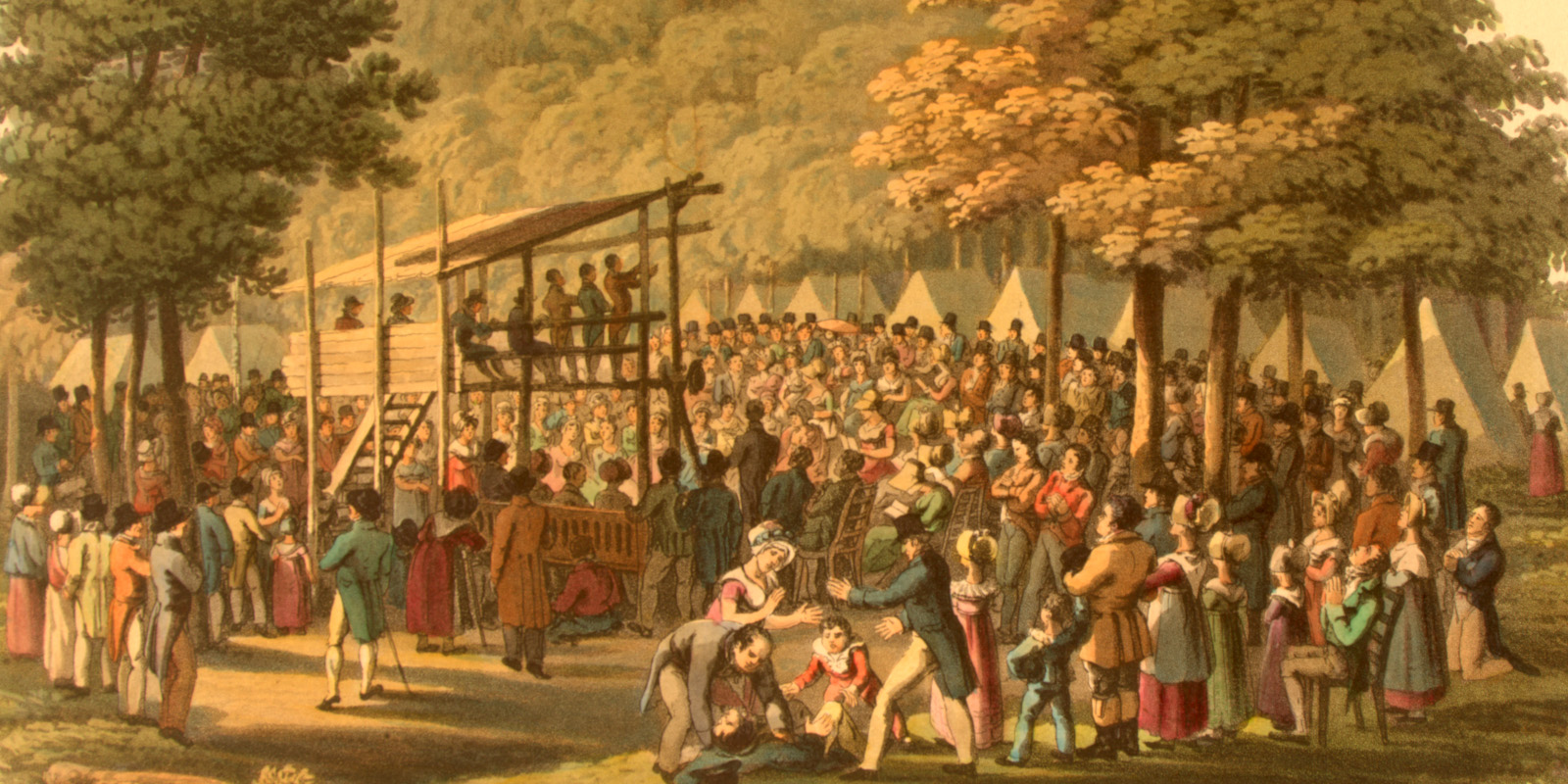
Methodist Camp Meeting from that Era (1819 engraving)
Extraordinary Prayer Preceded this Outpouring
The people that made up the caravan from Iredell to Randolph County were those who had spent the preceding 18 months in sincere prayer, specifically praying for a “refreshing from the presence of the Lord.”
The Revival Spread
When the group of 100 returned to their homes in Iredell County, the revival fires, having already been lit, spread.
► Three different prayer groups were established.
► The revival began affecting those who didn’t attend the meetings.
► Even with the dramatic life transformations and renewed passion for the Word of God, and for Christ himself, there were two denominations in Iredell County that were opposed to the revival, not approving of the human response to the severe conviction of sin.
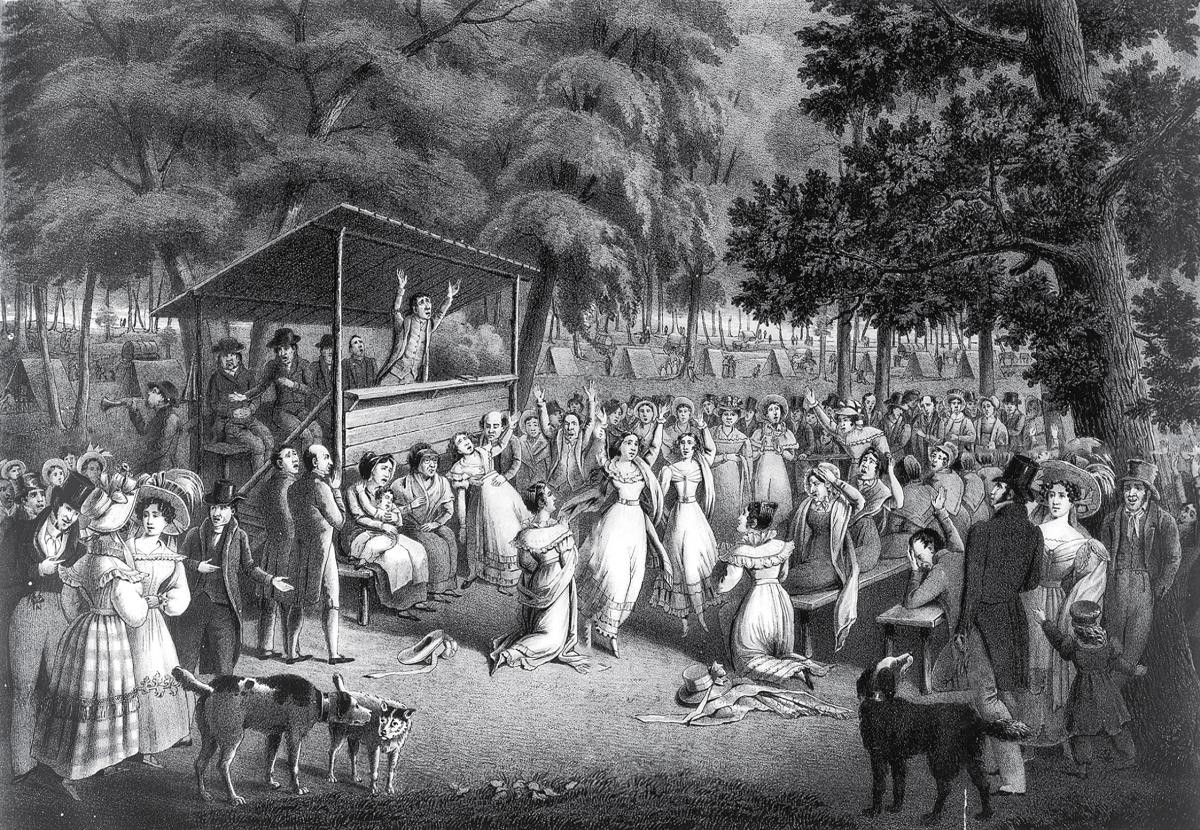
Camp Meeting from that Era (1829)
Camp Meeting in Cabarrus County
On the last week of January another camp meeting was scheduled for Concord, North Carolina. The number of wagons that arrived at the camp site, besides riding carriages, numbered about 108, with a total of 4,000 being present on Sunday.
When the meeting started on Friday it began to rain, and it continued till evening. Even with that cold rain (in January), many experienced the presence of God.
At 9 the next morning the campers were greeted with heavy sleet. Then it snowed until 4 p.m. Even with this inclement weather the people gathered at 10 o’clock that morning, exposed to the weather, and stood in that open setting until the sun went down. During that time many of the people were deeply affected by the presence of God.
The camp meeting concluded at 9 o’clock on Tuesday morning. The people who did not experience the presence of God during their stay were
struck with convictions on their return, and others after they went home.
Ministers Present at the Cabarrus County Camp Meeting
► 8 Presbyterians
► 1 Baptist
► 2 Methodists
Camp Meeting in Burke County
Two weeks after the camp meeting in Cabarrus County, there was another scheduled to be held in Morganton, North Carolina.
Second Camp Meeting in Randolph County
Cross Roads was the location where the second camp meeting was held in Randolph County. It was a location 10 miles south of where the first camp meeting was held.
Information about this camp meeting:
► Number present: 8,000 – 10,000.
► Many hundreds were overcome by the conviction power of the Holy Spirit.
► There were 262 wagons that arrived, not counting riding carriages.
► The meetings were held in 4 different locations at the camp ground.
► Number of ministers present:
….• 14 Presbyterians
….• 3 Methodists
….• 2 Baptists
….• 2 German Lutherans
….• 1 Dutch Calvinist
….• 1 Episcopalian
Camp Meeting at Mecklenburg County
Two weeks after the Cross Roads camp meeting in Randolph County, there was another held in Mecklenburg County.
Information about the Mecklenburg County camp meeting:
► Approximately 3,000 assembled
► Number of ministers present
….• 12 Presbyterians
….• 1 Baptist
….• 1 Methodist
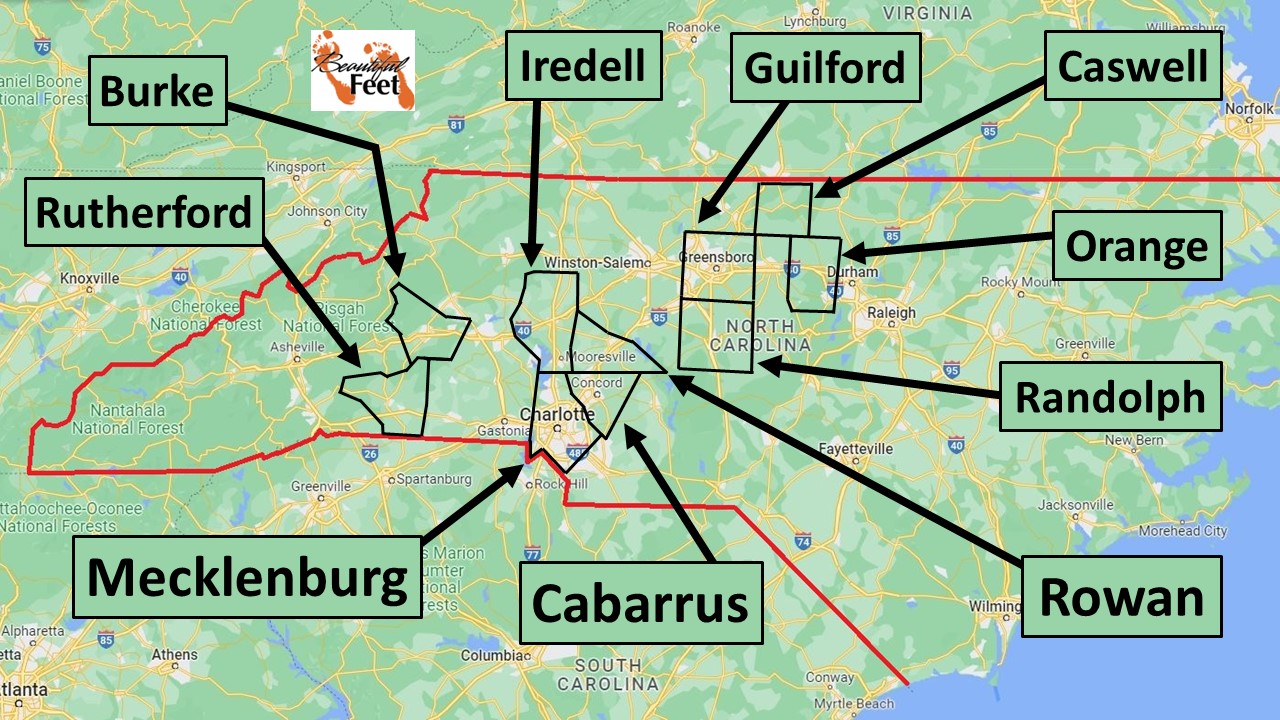
North Carolina outlined in red.
Counties where camp meetings were held are outlined in black.
Some of the Counties that Held Camp Meetings
► Burke County (Morganton, North Carolina)
► Caswell County (Providence, North Carolina)
► Cabarrus County (Concord, North Carolina)
► Guilford County, North Carolina
► Iredell County, North Carolina
► Mecklenburg County, North Carolina
► Orange County, North Carolina
► Randolph County, North Carolina (Cross Roads)
► Rowan County (Jersey Settlement)
► Rutherford County, North Carolina
Results of the Revival
According to James Hall, “Volumes might be written” on what he observed during these camp meetings. And “many of the scenes to which I have been witness baffle description.”
► The influence of the revival spread 200 miles from east to west and 100 miles from north to south.
► The different denominations were able to work together. During sermons the ministers did not discuss topics with which they had disagreements.
► Evangelism was conducted: Small groups were formed by the local congregations following the camp meetings. From these groups, prayer and personal evangelism were conducted. The groups (societies) made more of an effect in people’s lives than what the regular church services were able to accomplish.
► Communities were transformed: The morals of society in general was noticeably changed, even in locations where the revival did not reach.
► In all the meetings there had not been one person who had reverted to their former lifestyle (backslid).
► The revival spread to different locations in South Carolina.
Were the Camp Meetings Orderly—or Given over to Emotions?
Opponents of the revivals criticized the ministers of intentionally raising the people’s emotions just to get a reaction. They also accused the ministers of allowing the people’s emotions to get out of control.
Answering these charges was Rev. Samuel McCorkle, and responding to the question “Were the camp meetings out-of-order?” he replied:
No.—[what was experienced was] An awful sense of the majesty of God— a painful sense of sin—an earnest desire to be delivered from it, &c. &c. surely there is no disorder here.
McCorkle said he found no fault in men and women, boys and girls, crying out in desperation for salvation and freedom from sin. He used the New Testament example from Acts 2:37, which was evidence of the conviction of sin, following Peter’s sermon on the day of Pentecost:
Men and brethren what must we do to be saved.
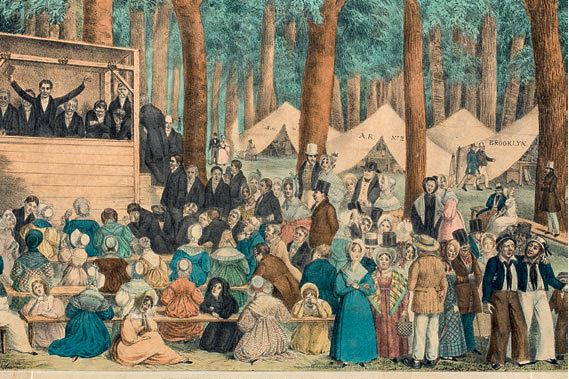
Camp Meeting from that Era (1836)
Evidence that the Manifestations Were Genuine
The ministers participating in these camp meetings indicated that they had seen the exact physical and emotional responses in vastly different locations. They said that this was not an example of learned behavior, as people who had never witnessed such things were exhibiting an emotional and physical response exactly the same as what others had, with the two never having seen such things before.
Typical Manifestations
The typical response of the people to the convicting power of the Holy Spirit was:
► Loud crying (for mercy and forgiveness of sins).
► Overwhelming guilt, followed by grief and terror of the coming judgment.
► Physical trembling of the body.
► Breathlessness.
► Fainting (swooning).
► Prostrations: losing all physical strength and falling to the ground. People experiencing this would lay motionless, as if they were paralyzed or asleep. This would at times last for up to 5 hours.
► Following the effects upon the body, and the people experiencing a genuine conversion experience, or knowing that their sins had been forgiven, their behavior changed to:
….• Rejoicing—“ecstatic joy.”
….• Children would be granted the grace to exhort in such a fashion that it made a tremendous impact on the listeners.
….• Overwhelming compassion and prayers ascended for family members to be saved.
….• Rest in deep contemplation, with a “placid serenity spread over the countenance,” and that visible change on the face was said to have lasted “not only for days, but weeks.”
Source
► A Narrative of a Most Extraordinary Work of Religion in North Carolina by James Hall
► Holy Fairs by Leigh Erich Schmidt
Return to List of Revival Stories
Chet & Phyllis Swearingen:
Office: (260) 920-8248
romans1015@outlook.com
Beautiful Feet
P.O. Box 915
Auburn, IN 46706

